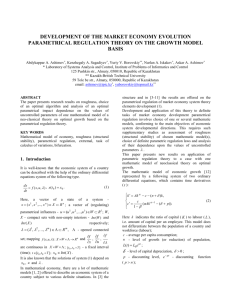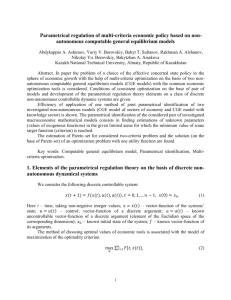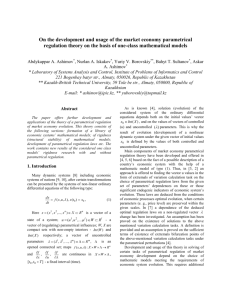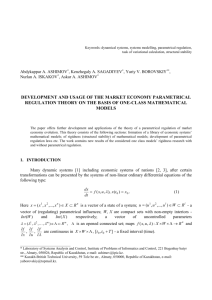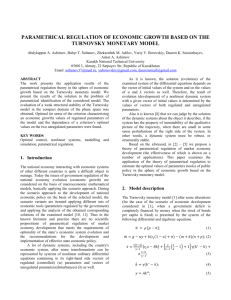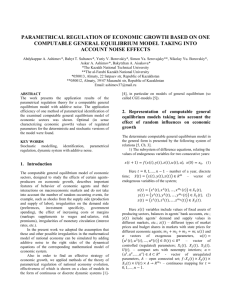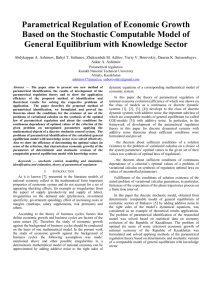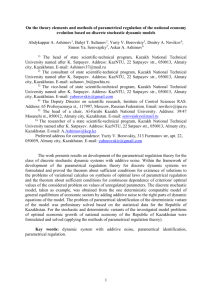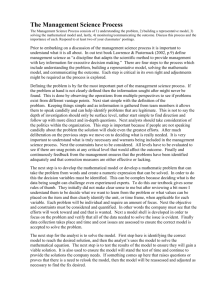399.00Kb
advertisement
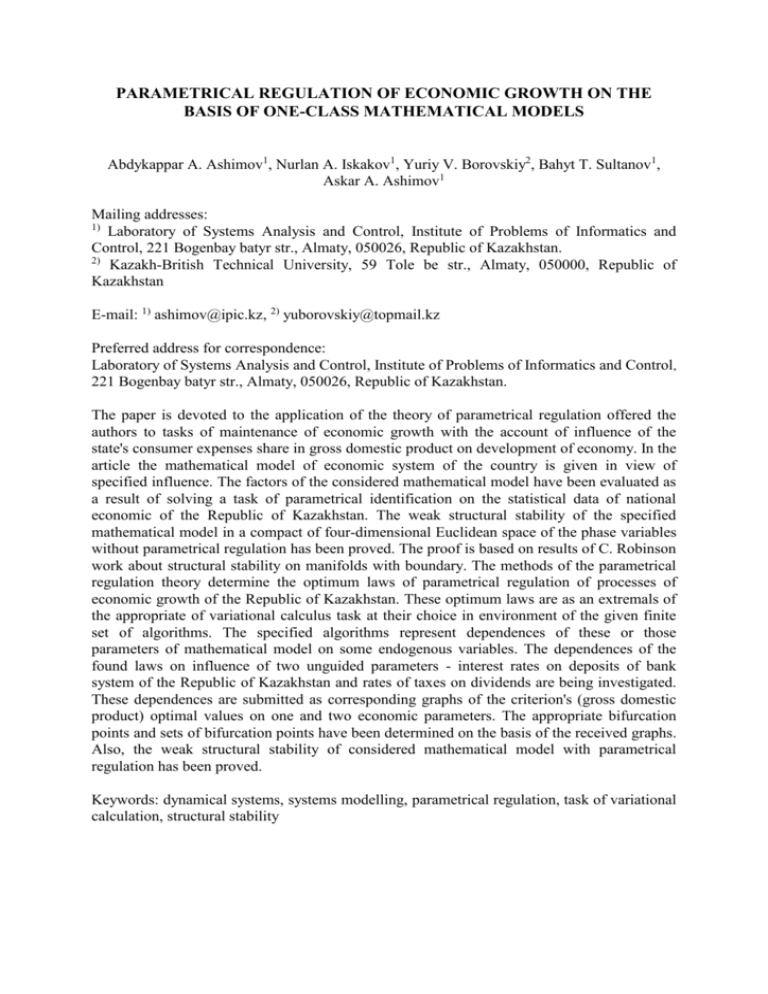
PARAMETRICAL REGULATION OF ECONOMIC GROWTH ON THE
BASIS OF ONE-CLASS MATHEMATICAL MODELS
Abdykappar A. Ashimov1, Nurlan A. Iskakov1, Yuriy V. Borovskiy2, Bahyt T. Sultanov1,
Askar A. Ashimov1
Mailing addresses:
1)
Laboratory of Systems Analysis and Control, Institute of Problems of Informatics and
Control, 221 Bogenbay batyr str., Almaty, 050026, Republic of Kazakhstan.
2)
Kazakh-British Technical University, 59 Tole be str., Almaty, 050000, Republic of
Kazakhstan
E-mail: 1) ashimov@ipic.kz, 2) yuborovskiy@topmail.kz
Preferred address for correspondence:
Laboratory of Systems Analysis and Control, Institute of Problems of Informatics and Control,
221 Bogenbay batyr str., Almaty, 050026, Republic of Kazakhstan.
The paper is devoted to the application of the theory of parametrical regulation offered the
authors to tasks of maintenance of economic growth with the account of influence of the
state's consumer expenses share in gross domestic product on development of economy. In the
article the mathematical model of economic system of the country is given in view of
specified influence. The factors of the considered mathematical model have been evaluated as
a result of solving a task of parametrical identification on the statistical data of national
economic of the Republic of Kazakhstan. The weak structural stability of the specified
mathematical model in a compact of four-dimensional Euclidean space of the phase variables
without parametrical regulation has been proved. The proof is based on results of C. Robinson
work about structural stability on manifolds with boundary. The methods of the parametrical
regulation theory determine the optimum laws of parametrical regulation of processes of
economic growth of the Republic of Kazakhstan. These optimum laws are as an extremals of
the appropriate of variational calculus task at their choice in environment of the given finite
set of algorithms. The specified algorithms represent dependences of these or those
parameters of mathematical model on some endogenous variables. The dependences of the
found laws on influence of two unguided parameters - interest rates on deposits of bank
system of the Republic of Kazakhstan and rates of taxes on dividends are being investigated.
These dependences are submitted as corresponding graphs of the criterion's (gross domestic
product) optimal values on one and two economic parameters. The appropriate bifurcation
points and sets of bifurcation points have been determined on the basis of the received graphs.
Also, the weak structural stability of considered mathematical model with parametrical
regulation has been proved.
Keywords: dynamical systems, systems modelling, parametrical regulation, task of variational
calculation, structural stability
1.
INTRODUCTION
Many dynamic systems [1] including economic systems of nations [2, 3], after certain
transformations can be presented by the systems of non-linear ordinary differential equations
of the following type:
dx
f ( x, u , ), x(t 0 ) x0 .
dt
Here
x ( x1 , x 2 ,..., x n ) X R n
is
a
vector
of
(1)
a
state
of
a
system;
u (u1 , u 2 ,..., u l ) W R l - a vector of (regulating) parametrical influences; W, Х are
compact sets with non-empty interiors - Int (W ) and Int ( X ) respectively; a vector of
uncontrolled parameters (1 , 2 , , m ) R m , is an opened connected set; maps
f ( x, u, ) : X W R n and
f f f
,
,
are continuous in X W , [t 0 , t 0 T ] - a
x u
fixed interval (time).
As is known [4], solution (evolution) of the considered system of the ordinary
differential equations depends both on the initial values’ vector x0 Int ( X ) , and on the
values of vectors of controlled (u) and uncontrolled (λ) parameters. This is why the result of
evolution (development) of a nonlinear dynamic system under the given vector of initial
values x0 is defined by the values of both controlled and uncontrolled parameters.
Main components of market economy parametrical regulation theory have been
developed and offered in [4, 5, 6] based on the fact of a possible description of a country’s
economic system with the help of a mathematic model of type (1). Thus, in [3, 2] an approach
is offered to finding the vector u values in the form of extremals of variation calculation task
on the choice of parametrical regulation laws from the given set of parameters’ dependences
on these or those significant endogenic indicators of economic system’s evolution. These laws
are deduced from the conditions of economic processes optimal evolution, when certain
parameters (e. g., price level) are preserved within the given scales. In [7] a dependence of the
deduced optimal regulation laws on a non-regulated vector λ change has been investigated. An
assumption has been proved on the existence of solutions to the above mentioned variation
calculation tasks. A definition is provided and an assumption is proved on the sufficient terms
of existence of extremals bifurcation points of the above-mentioned variation calculation tasks
under the parametrical perturbations [4].
Development and usage of this theory in solving of certain tasks of parametrical
regulation of market economy development depend on the choice of mathematic models
meeting the requirements of economic system evolution. This requires additional study of
roughness (structural stability) of the models chosen [1, 12]. The results of this research allow
considering an adequate nature of mathematic models as well as a structural stability of the
economic system described by this model. Development and application of a theory for the
chosen models require that definite parametrical regulation laws should be chosen, and the
dependence of the chosen laws on the values of the non-controlled parameter λ should be
studied as well. The paper presents latest results of development and application of the
parametrical regulation theory to a mathematical model of an economic system for research of
influence of the consumer charges of the state on development of economy [10].
2. RESEARCH OF RIGIDNESS (STRUCTURAL STABILITY) OF A
MATHEMATIC MODEL WITHOUT PARAMETRICAL REGULATION
2.1. MODEL DESCRIPTION
The considered task is solved on the basis of the parametrical regulation theory and on
the sample of the following mathematical model [10], which presents the phase restrictions
and restrictions in the permitted form of the researched variational calculus task at the choice
of parametric regulations laws by the following relationships:
dM I
M ,
dt
pb
(2)
dQ
Mf ,
dt
p
(3)
dLG
rG LG G n p n L sR L nO (d P d B ) , (4)
dt
dp
Q
p,
dt
M
Rd RS L
ds s
d
S
max 0,
, R min{ R , R } ,
S
dt
R
Lp
dp
1
1
(5)
(6)
LG ,
(7)
r2 LG ,
(8)
d B r2 LG ,
s
x
1
1 p
(9)
1
,
(10)
R d Mx ,
(11)
O 0 pMf ,
(12)
G pMf ,
(13)
1
1 1
f 1 1
x ,
(14)
L (1 n L ) sR d ,
(15)
I
1
(1 )n p
(1 n
p )
G
(16)
n0 (d d ) n p nL (1 nL )n p sR ( rG ) L ,
B
P
O
L
*
O G L I ,
R S P0A exp( p t )
1
L
.
,
1
pP0 exp( p t )
p
(17)
(18)
Here: M stands for total production capacity; Q – the general stock of the goods in the
market; LG – total amount of a public debt; p – price level; s – average real wages; LP volume of manufacture debts; d P and d b - accordingly owner’s and bank’s dividends; R d
and R S - accordingly demand and supply of labor; , - parameters of function f(x); x solution of f x s p equation; L and O - accordingly consumer expenses of
employees and owners; I - investment flow; G - consuming government spending; ξ norm of reservation; β - the attitude of average rate of return from commercial activity to the
rate of return of the investor; r2 – interest rate on deposits; rG - interest rate on government
bonds; O - coefficient of owners disposition to consumption; π - state's consumer expenses
share in gross domestic product; n p , nO , nL - accordingly rates of taxes on cash flow,
dividends and income of employees; b - rate of fund-capacitance of power unit; μ - factor of
power unit leaving which is caused by degradation; * - norm of amortization; α - time
constant; Δ - time constant, which is set of characteristic time scale of process relaxation of
wage; P0 , P0A - initial number of workers and an aggregate number able-bodied accordingly;
p >0 - appointed tempo of demographic growth; ω – per capita consumption in group of
employees.
The model parameters and initial conditions for the differential equations (2)-(6) were
obtained on the basis of economic data of the Republic of Kazakhstan [17] at 1996-2000 ( r2
= 0.12; rG = 0.12; β = 2; n p = 0.08; nL = 0.12; s = 0.1; nO = 0.5; μ = μ* = 0.012; Δ=1) or are
assessed through the solution of the parametric identification task (ξ=0.1136; π=0.1348;
δ=0.3; ν=34; O = 0.05; b = 3.08; α = 0.008; Q(0) = - 125000).
2.2. RESEARCH OF RIGIDNESS (STRUCTURAL STABILITY) OF THE
MATHEMATIC MODEL
Let us conduct statement of rigidness (structural stability) of a model under
consideration in a closed field Ω, basing on the definition of rigidness and the theorem on
sufficient conditions of rigidness [12]. The conditions are as follows.
Let N be some set and N be such a compact subset N that the closure of interior of N
would be N. Let some vector field be given in the area of set N in N , then this field would
determine the C1 flow f in this area. The chain recurrent set of the flow f on the N is marked as
R( f , N ) .
Let the R( f , N ) be contained inside the N and have a hyperbolical structure; besides
this, the f on the R( f , N ) would satisfy the transversality conditions on stable and unstable
manifolds. Then the flow f on the N is weakly structurally stable. Particularly, if the R( f , N )
is an empty subset, then the flow f weakly structurally stable on the N.
We will assume further that R d > R S . In this case differential equations (6) are replaced
with the conditions of stability of variable s.
Statement 1. Let N be a compact set in area ( M 0, Q 0, p 0) or
( M 0, Q 0, p 0) , of the phase area of differential equations system obtained from the (218), i.е. four-dimension area of variables ( M , Q, p, LG ) ; closure of interior of N coincides
with the N. Then the flow f determined by the (2-18) is weakly structurally stable on the N.
F.i., a parallelepiped could be chosen as the N, with boundaries
M M min , M M max , Q Qmin , Q Qmax , p pmin , p pmax , LG LG min , LG LG max . Here
0 M min M max , Qmin Qmax 0 or 0 Qmin Qmax , 0 pmin pmax , LG min LG max .
The proof. To start with, let us make sure that the half-trajectory of the flow f beginning
in any point of the set N under a certain value of t (t>0) comes out from the N. Let us consider
any half-trajectory starting in the N. There are two cases possible for it if t 0 : all the halftrajectory points are left in the N, or for a certain t a point of the trajectory does not belong to
dp
Q
p, that the
the N. It follows in the first case from equation (5) of the system
dt
M
variable p(t) for all the t 0 has got a derivative that is either more than some positive
constant under the N ( M 0, Q 0, p 0) or less some negative constant under the
N ( M 0, Q 0, p 0) , that is, the p(t) unlimitedly rises or tends to zero under the
unlimited increase of the t. This is why, the first case is impossible, the orbit of any point from
the N comes out from the N.
As far as any chain recurrent set R( f , N ) is an invariant set of this flow, in case of its
non-emptiness it should consist of whole orbits. Consequently, in our case the R( f , N ) is
empty. The assumption has been proved.
3.
PARAMETRICAL REGULATION OF ECONOMIC GROWTH
3.1. THE TASK OF CHOICE OF EFFECTIVE PARAMETRICAL REGULATION LAW
The possibility of a choice of the optimum law of parametrical regulation at a level of
one of two parameters ξ (j = 1) and π (j = 2), and in the interval of time [t0 , t0 T ] were
investigated in the environment of the following algorithms.
1)U1 j (t ) k1 j
M M0
const j ,
M0
3)U 3 j (t ) k3 j
p p0
const j ,
p0
2)U 2 j (t ) k 2 j
M M0
const j ,
M0
4)U 4 j (t ) k 4 j
p p0
const j .
p0
(19)
Here: U ij - is a i-law of regulation of j-parameter, i 1 4, j 1 2 ; t 0 – is the time of
the start of regulation, t t 0 , t 0 T ; k ij is a tuned factor of the relevant law ( kij 0 i );
M 0 , p0 are initial values of the corresponding variables; const j is a constant that is equal to
the assessment of the values of j-parameter by the results of parametric identification.
Handling the law U ij under the fixed k ij in the system (2-18) means the substitution function
U ij from (19) in equations of the system (2-18) instead of a parameter ξ or π.
The task of selection of a optimal set of r (r 2) parametrical regulation laws for the
economic system at the level of r of the economic parameters (ξ, π) was set in the following
form: to find on the basis of mathematical model (2–18) an optimal parametrical regulation r
laws in an environment of the set of algorithms (19), i.е. to find r optimal laws (and its factors
k ij ) out of the set { U ij }, which would have provided a maximum for the criteria
K
1 t0 T
Y (t )dt ,
T t0
(20)
where Y Mf is a gross domestic product.
The closed set in the space of continuous vector-functions of target variables of the
system (2) - (18) and regulating parametrical influences is defined by the following conditions
p(t ) p ** (t ) 0.09 p ** (t ),
( M (t ), Q(t ), LG (t ), p(t ), s(t )) X ,
0 u j a j , i 1,4, j 1,2, t [t 0 , t 0 T ].
(21)
Here a j - is the biggest possible value of j-parameter, p (t ) are the values of price levels
under the r regulation laws; p ** (t ) are model (counting) values of price levels without
parametrical regulation, X is a compact set of allowable values of the specified parameters.
The formulated task is solved in two stages:
- at the first stage optimal values of factors k ij for each set of r laws U ij are defined by
way of their values sorting in relevant intervals (quantized with small step), which provide
maximum K under the restrictions (21);
- at the second stage an optimal parametrical set of r regulation laws of a parameter
based on the first stage results for the maximum value of criterion K will be chosen.
The results of the numerical solution of the problem of choosing an optimum
parametrical regulation law at a level of one of economic parameters for economic system of
the state show that the best result K 177662 can be received via the usage of the following
regulation law
0.095
M M0
0.1136 .
M0
(22)
Let us notice that the value of the criterion without usage of the parametrical regulation
equals to K 170784 .
3.2. RESEARCH OF DEPENDENCE OF THE OPTIMUM LAWS OF PARAMETRICAL
REGULATION ON THE VALUES OF UNCONTROLLED PARAMETERS
The following tasks of variational calculation have been solved for research of the
specified dependences of item 3.2.
3.2.1. The dependence of optimum value of criterion of a task of variational
calculation (19-21) at the level of one economic parameter on mathematical model non-
controlled parameter
r2
has been investigated in this item. Here the possible values of
parameter r2 belong to some segment [a, b].
The calculating experiment brought about the graphs of dependence of the optimal
value of criterion K on parameter values r2 (in percents) for the given set of algorithms (19)
(see fig. 1). The application of a numerical method allows to find a extremal bifurcation point
of a considered task by an error up to 0.001: r2* 18.0 . Two laws ( U 21 and U 41 ) are
optimum for this value of parameter
equal 173381.
r2 . The corresponding value of criterion K for them is
Designations:
- U 41 ,
- U 32 ,
- U 21 ,
- U12 ,
- without regulation.
Fig 1. Graphs of dependences of the criterion’s K optimal values on the parameters of interest
rates on deposits r2.
3.2.2. The dependence of optimum value of criterion of a task of variational
calculation (19-21) at the level of two economic parameters on mathematical model noncontrolled parameter r2 has been investigated in this item. Here the possible values of
parameter r2 belong to some segment [a, b].
The calculating experiment brought about the graphs of dependence of the optimal
value of criterion K on parameter values r2 (in percents) for all possible sets of algorithms
with unzero optimum values of factors k ij (see fig. 2). The application of a numerical method
allows to find a extremal bifurcation point of a considered task by an error up to 0.001:
r2* 0.075 . Two pairs of laws - {U 21,U 32} and {U 21,U12} are optimum for this value of
parameter
r2 . The corresponding value of criterion K for them is equal 187487.
Designations:
- U 41 and U 32 ,
- U 41 and U12 ,
- U 21 and U 32 ,
- U 21 and
U12 .
Fig 2. Graphs of dependences of the criterion’s K optimal values on the parameters of interest
rates on deposits r2.
3.2.3. The dependence of optimum value of criterion of a task of variational
calculation (19-21) at the level of one economic parameter on mathematical model noncontrolled two-dimensional parameter (r2 , nO ) has been investigated in this item. Here
the possible values of parameter belong to some rectangle Λ.
The calculating experiment [6] brought about the graphs of dependence of the
optimal value of criterion K on parameter values (r2 , nO ) for each of the 8 probable laws
U ij , i 1,4, j 1,2 . Figure 3 presents the given graphs for the rules U 21 and U 41 , which give
the biggest value of a criterion in area Λ, the intersection of corresponding surfaces and the
projection of this intersection upon the plane of values λ, consisting of the bifurcation points
of this parameter. This projection divides the rectangle Λ into two parts, where the controlling
rule
U 21(t ) k 21
M M0
const1
M0
(23)
is optimal for one part, and
U 41(t ) k 41
p p0
const1
p0
is optimal for the other; at the projection itself both rules are optimal.
(24)
Fig. 3. Graphs of dependences of the criterion’s K optimal values on the parameters of interest
rates on deposits r2 and rates of taxes on dividends nO.
3.3. RESULTS OF RESEARCH OF RIGIDNESS (STRUCTURAL STABILITY) OF THE
MATHEMATICAL MODEL WITH PARAMETRICAL REGULATION
Application of the optimal laws of parametrical regulation found in above items means
replacement of corresponding parameters by the relevant functions in the equations (7, 8, 13,
16), the rest equations of the model remain unchanged. The proof of the weak structural
stability of the mathematical model given in i. 2.2. and basing on equation (5), allows to find
the following.
Statement 2. Let N be a compact set in area ( M 0, Q 0, p 0) or
( M 0, Q 0, p 0) , of the phase area of the differential equations system obtained from the
(2-18), i.e. four-dimension area of variables ( M , Q, p, LG ) ; closure of interior of N coincides
with the N. Then the flow f determined by the (2-18) and U 21 or U 41 or {U 21 , U 32 } or
{U 21 , U12 } is weakly structurally stable on the N.
4. CONCLUSIONS
This paper gives the following latest results of the development and usage of the
parametrical regulation theory for a mathematical model of an economic system for research
of influence of the consumer charges of the state on development of economy [10]:
- the model’s weak structural stability for compact areas of its phase space has been
proved;
- the tasks of choice of optimal parametrical regulation laws have been solved for
maximizing an average gross domestic product of a country under some limitations upon price
level increase;
- a dependence of the found optimal laws on the values of non-controlled parameters
has been defined and the optimal laws bifurcation points and the sets of optimal laws
bifurcation points have been found;
- a weak structural stability of a model preserved under the usage of the chosen
parametrical regulation laws influenced by the non-controlled parameters of the model has
been proved.
REFERENCES
[1] Anosov D.V., Rough systems, Proceedings of the USSR Academy of Sciences’ Institute of
Mathematics, Vol. 169, 1985, pp. 59-96 (in Russian).
[2] Ashimov A., Borovskiy Yu., Ashimov As., Parametrical Regulation Methods of the
Market Economy Mechanisms, Systems Science, Vol. 35, No. 1, 2005, pp. 89-103.
[3] Ashimov А., Borovskiy Yu., Ashimov As., Volobueva O., On the choice of the effective
laws of parametrical regulation of market economy mechanisms, Automatics and
Telemechanics, No 3, 2005, pp. 105-112 (in Russian).
[4] Ashimov А., Sagadiyev К., Borovskiy Yu., Iskakov N., Ashimov As., Parametrical
regulation of nonlinear dynamic systems development, Proceedings of the 26th IASTED
International Conference on Modelling, Identification and Control, Innsbruck, Austria, 2007,
pp. 212-217.
[5] Ashimov А., Sagadiyev К., Borovskiy Yu., Iskakov N., Ashimov As., Elements of the
market economy development parametrical regulation theory, Proceedings of the Ninth
IASTED International Conference on Control and Applications, Montreal, Quebec, Canada,
2007, pp. 296-301.
[6] Ashimov А., Sagadiyev К., Borovskiy Yu., Iskakov N., Ashimov As., On the market
economy development parametrical regulation theory, Proceedings of the 16th International
Conference on Systems Science, Wroclaw, Poland, 2007, pp. 493-502.
[7] Ashimov А., Sagadiyev К., Borovskiy Yu., Ashimov As., On Bifurcation of Extremals of
one Class of Variational Calculus Tasks at the Choice of the Optimum Law of Parametrical
Regulation of Dynamic Systems, Proceedings of Eighteenth International Conf. On Systems
Engineering, Coventry University, 2006, pp. 15-19.
[8] Gukenheimer J., Cholmes P., Nonlinear fluctuations, dynamic systems and bifurcations of
vector fields, Institute of Computer Researches, Moscow – Izhevsk, 2002 (in Russian).
[9] Matrosov V.М., Chrustalyov М.М., Arnautov О.V., Krotov V.F., On the highly aggregate
model of development of Russia, The Proceedings of the 2nd International conference
“Analysis of instability development based on mathematical modeling”, Moscow, 1992, pp.
182-243 (in Russian).
[10] Petrov A., Pospelov I., Shananin A., Experience of mathematical modeling of economy,
Energoatomizdat, Moscow, 1996 (in Russian).
[11] Pontryagin A., The ordinary differential equations, Nauka, Moscow, 1970 (in Russian).
[12] Robinson C., Structural Stability on Manifolds with Boundary, Journal of differential
equations, No. 37, 1980, pp. 1-11.
Table with captions
1.
INTRODUCTION
2.
RESEARCH OF RIGIDNESS (STRUCTURAL STABILITY) OF A MATHEMATIC
MODEL WITHOUT PARAMETRICAL REGULATION
2.1. MODEL DESCRIPTION
2.2. RESEARCH OF RIGIDNESS (STRUCTURAL STABILITY) OF THE
MATHEMATIC MODEL
3.
PARAMETRICAL REGULATION OF ECONOMIC GROWTH
3.1. THE TASK OF CHOICE OF EFFECTIVE PARAMETRICAL REGULATION LAW
3.2. RESEARCH OF DEPENDENCE OF THE OPTIMUM LAW OF PARAMETRICAL
REGULATION ON THE VALUES OF UNCONTROLLED PARAMETERS
3.3. RESULTS OF RESEARCH OF RIGIDNESS (STRUCTURAL STABILITY) OF THE
MATHEMATICAL MODEL WITH PARAMETRICAL REGULATION
4.
CONCLUSIONS
REFERENCES
